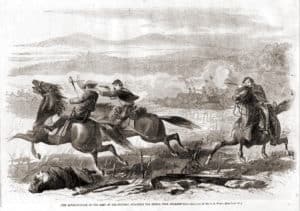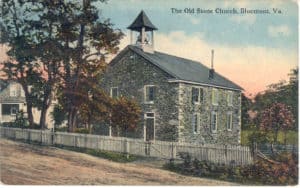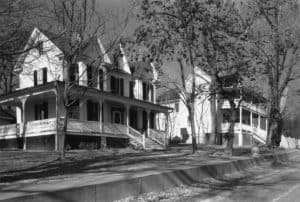Bluemont
In 1813, William Clayton willed four lots to his children. In 1825 William’s son Amos Clayton donated one-half acre of land for a school, nondenominational church, and village meeting hall–the Snickersville Academy – a log structure that now stands unattended across the turnpike from Clayton Hall. The first postmaster came on board in 1807. The village was incorporated .
During the Civil, Snickers Gap was a strategic pathway between the much fought-over Shenandoah Valley and Union-occupied Northern Virginia. Both armies traveled back and forth using Snickers Gap.
The Battle of Snickersville from Harpers Magazine
In 1862 the village of Snickersville, now Bluemont, saw an engagement between Union cavalry of the Army of the Potomac and Colonel John Singleton Mosby’s irregular forces. Then, In 1864, General Philip Sheridan ordered Major General Wesley Merritt to make Snickersville his “point of concentration” and scorch the earth east of the Blue Ridge to stop the area from providing food and other support to Confederate troops.
Wrote George E. Plaster in 1902: “At the end the wreck was appalling. The farms adjacent were stripped of fences, barns were burned, all livestock driven off, and means for providing for future wants exhausted. For miles around extended a fenceless, prairie-like plain.”
The “Battle of Snickersville,” October 22, 1862 was made known to the nation through an illustration in Harper’s Magazine: “The Advance-Guard of the Army of the Potomac Attacking the Rebels Near Snickersville.” The dramatic print shows two Union cavalrymen in the foreground chasing a rebel on horseback above a prostrate combatant
After 1900, another hotel, the Loudoun House, opened in the village. Loudoun Seminary opened as a finishing school for girls, with boys attending as day students. Later, under the name of the Willow Brook Academy it was a school for boys. Stage coaches connected Snickersville and Berryville with Hamilton when it was the railway terminus.
The E.E. Lake store, now restored, was built around 1901. The space offered a cluster of shops and services—a general store, an ice cream parlor, a barbershop, and the post office, and a meeting and dance hall upstairs. A branch of the Loudoun National Bank of Leesburg operated there for a while, but closed after robbers opened the safe with explosives in 1907.
Snickersville was already developing a reputation for hosting summer visitors, the Southern Railroad (later called the Washington & Old Dominion) extended its tracks west from Round Hill, with funding provided by Southern’s owner, J.P. Morgan.
To enhance the tourist appeal of a village with the potentially risible moniker of “Snickersville,” the railroad named its station “Bluemont.” The post office soon changed its name to match.
Later in the 20th century, Bluemont slipped into a decline. Instead of the socially bustling hotels and boarding houses of the village’s heyday with their “drummers” (traveling salesmen) and fashionable guests, the area around Bluemont became a place of farming and summer cottages for families. The Blue Ridge Inn burned to the ground in 1912; the railway ceased Bluemont operations in 1939; and Route 7 remained a winding two-lane road until the 1970s, putting Bluemont well off the beaten track for decades. The 1960s and 1970s reportedly found the town a bit worn at the heels as, in some quarters, Elizabeth Avenue (now Railroad Street) took on the disparaging nickname of “Vietnam.”
Today, Bluemont has found a share of prosperity. Many of its year-round residents are linked to the greater Washington, D.C. commuting area. Labors of love, such as the Bluemont Citizens Association’s preservation of the E.E. Lake Store, the late Bruce Brownell’s renewal of the Snickersville Store, Rosemary Stanger’s re-creation of the train station, and Butch Nielson’s restoration of the Old Dance Hall, maintain the attractiveness and utility of Bluemont’s commercial center.


